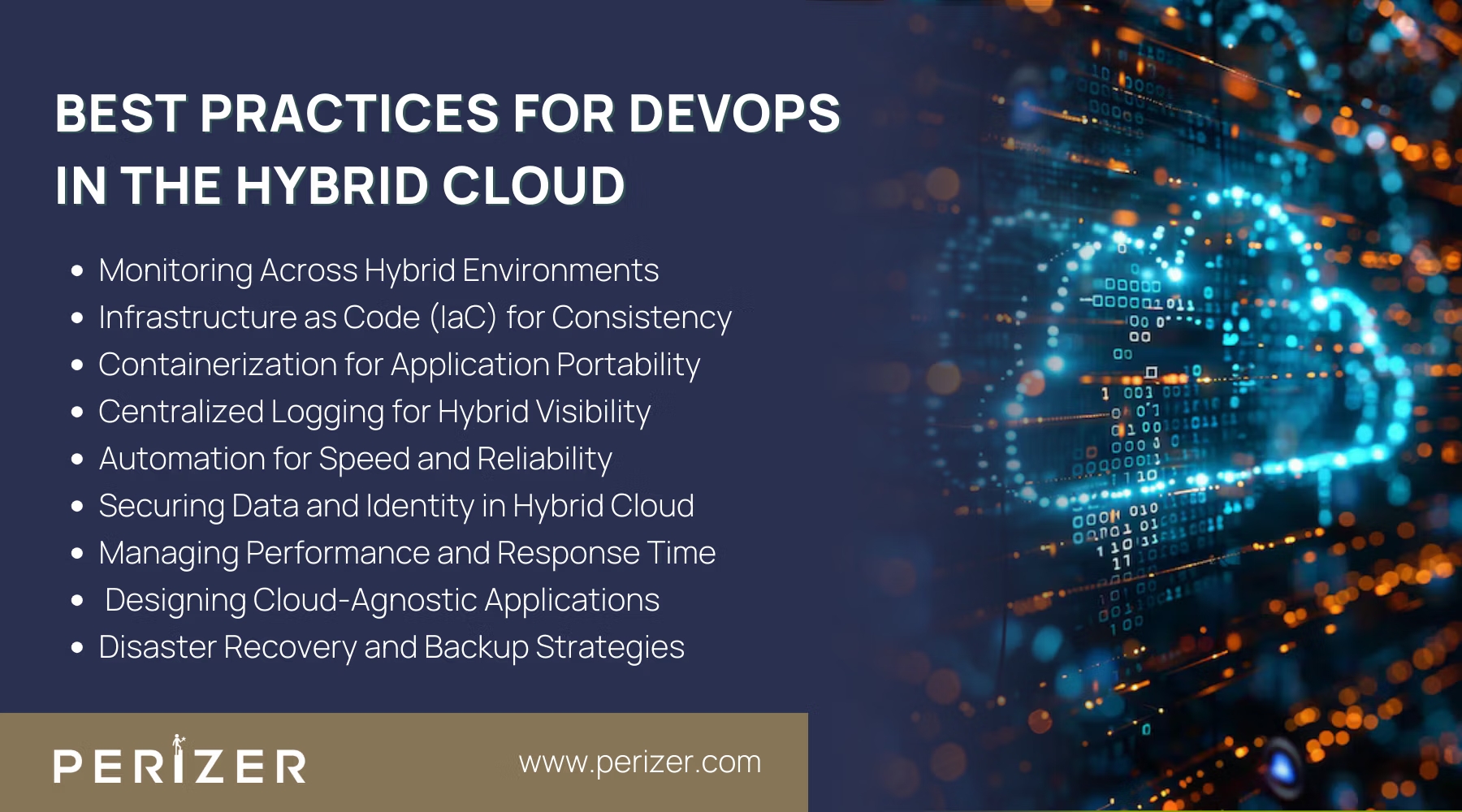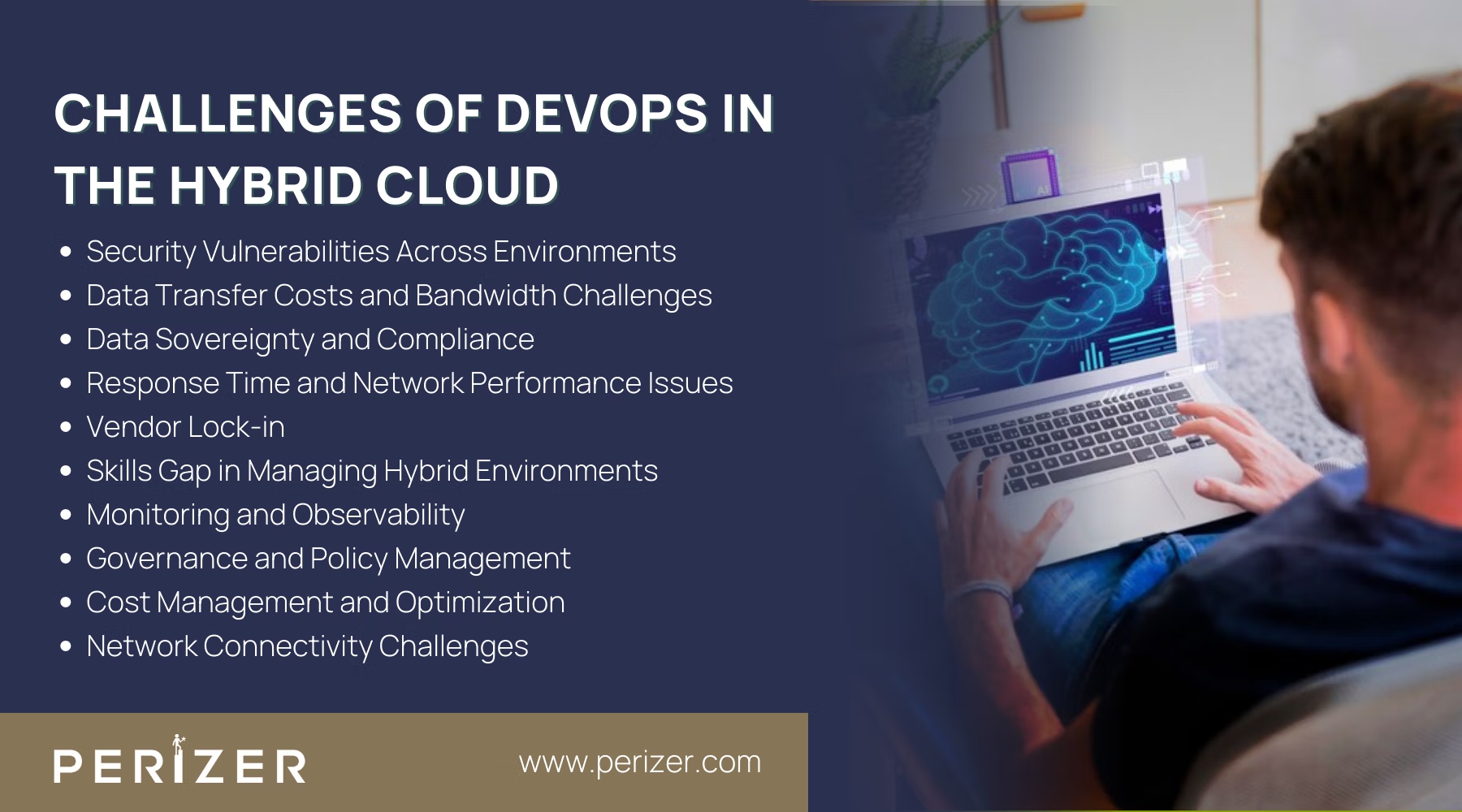Best Practices for DevOps in the Hybrid Cloud
Explore advanced best practices for DevOps in hybrid cloud environments, from automation to security, ensuring seamless integration across all platforms.

As more organizations adopt hybrid cloud solutions, the challenge of keeping DevOps running smoothly across both cloud and on-prem systems becomes increasingly important. While the hybrid cloud brings incredible flexibility and scalability, it can also introduce challenges that disrupt your DevOps workflow if not managed carefully.
If your DevOps approach isn’t meeting the demands of a hybrid cloud, you may be missing key opportunities for optimization and growth. Adopting advanced best practices for hybrid cloud environments like automating infrastructure, improving security, and streamlining workflows will help you uncover the full potential of your setup and keep operations running smoothly.
Here, we’ll cover essential best practices that ensure your DevOps approach is strong, efficient, and optimized for hybrid cloud success.
Best Practices for DevOps in the Hybrid Cloud

1. Monitoring Across Hybrid Environments
In a hybrid cloud environment, monitoring is more than just keeping tabs on your cloud services. You must monitor both your on-premises infrastructure and cloud resources in a unified manner. To achieve this, you need to select tools that can offer a comprehensive view of all environments.
By using platforms like Prometheus or Grafana, which allow you to centralize your metrics from both the cloud and on-premises systems. This gives you real-time visibility, enabling you to detect performance issues before they impact users. Don’t just rely on basic monitoring; implement advanced monitoring strategies like anomaly detection powered by AI, so your system can alert you even to subtle problems.
2. Infrastructure as Code (IaC) for Consistency
When managing a hybrid cloud environment, manual infrastructure provisioning isn’t scalable. You need infrastructure that’s consistent, replicable, and reliable. Infrastructure-as-Code (IaC) allows you to define your infrastructure using tools like Terraform, and CloudFormation, ensuring that every deployment, whether on-prem or in the cloud, is identical.
To get the most out of IaC, integrate it into your CI/CD pipeline. Automate the provisioning and de-provisioning of environments using scripts, which reduces human errors and ensures that all environments are always in sync.
For example, use Terraform to create a common language for both your on-prem and cloud environments, ensuring that every piece of infrastructure behaves the same, regardless of where it lives.
3. Containerization for Application Portability
One of the key challenges in hybrid cloud setups is application portability. Moving workloads between on-premises and cloud environments can be complex and time-consuming. Containerization, using tools like Docker and Kubernetes, is a solution to this problem.
You can package your applications in containers so they remain consistent, whether running on your local servers or in the cloud. Kubernetes takes it one step further by orchestrating these containers, allowing you to scale applications dynamically. By abstracting away the underlying infrastructure, you make your applications cloud-agnostic, meaning they can run anywhere with minimal modification.
4. Centralized Logging for Hybrid Visibility
In a hybrid cloud, your logs are scattered across different environments. Having a centralized logging system is crucial for debugging, security audits, and performance tuning. Centralized logging tools like the ELK Stack (Elasticsearch, Logstash, and Kibana) or managed solutions such as AWS CloudWatch give you a unified view of your logs.
So, ensure that your logs from both on-prem and cloud environments flow into a single location. Use Logstash to collect and parse logs, no matter their source, and Elasticsearch to store them. This makes it easier to search and analyze logs across environments, speeding up incident response time. Automate this process further by setting alerts for specific log patterns, helping you catch issues before they escalate.
5. Automation for Speed and Reliability
In hybrid cloud DevOps, automation is the backbone of efficiency. Automation reduces errors and accelerates delivery. Tools like Jenkins, GitLab CI, or GitHub Actions help automate your CI/CD pipeline, making deployment across multiple environments faster and more reliable.
You can Implement end-to-end automation for not just application deployment but also for infrastructure provisioning, testing, and monitoring. For example, configure Jenkins to automate the build, test, and deploy phases of your application across on-prem and cloud environments, ensuring that each phase is triggered automatically after the previous one completes. Use Terraform scripts to automatically provision cloud infrastructure whenever a new application version is pushed.
6. Securing Data and Identity in Hybrid Cloud
Security is non-negotiable, and when working in a hybrid cloud, the stakes are even higher. Data is constantly moving between on-premises and cloud environments, making it vulnerable to breaches. To protect your data, you need robust encryption strategies—both at rest and in transit.
You can start by encrypting all data transfers between on-premises and cloud systems. Use SSL/TLS for encrypting data in transit and ensure that all storage volumes in both environments are encrypted at rest. Additionally, adopt a unified identity management system like AWS IAM or Azure AD that spans both on-prem and cloud environments. This ensures that your access controls are consistent across the board, reducing the chances of unauthorized access.
7. Managing Performance and Response Time
Response is a common issue when transferring data between on-premises systems and the cloud. You can’t afford to have delays that affect application performance, especially in a production environment.
You can consider edge computing for workloads that require low latency. By placing compute resources closer to the data source, edge computing can significantly reduce latency issues in hybrid environments. Additionally, optimize your network bandwidth by compressing data before transfer and leveraging caching strategies. Tools like AWS Direct ConnectorAzure ExpressRoute can help establish dedicated, high-bandwidth connections between your on-prem and cloud environments, ensuring faster data transfers.
8. Data Management and Integration
Data management becomes more complex in a hybrid cloud environment. Your data might reside in multiple locations—on-prem servers, cloud databases, or even edge devices. Effective data management involves understanding data gravity and ensuring smooth integration across all these environments.
You can begin by creating a unified data architecture that spans on-prem and cloud systems. Use tools like Apache Kafka for real-time data streaming across environments, ensuring that your data flows seamlessly between systems. For batch data processing, integrate cloud-based data lakes with your on-prem databases, creating a hybrid data ecosystem that supports both operational and analytical workloads.
9. Designing Cloud-Agnostic Applications
Hybrid cloud environments require applications to be flexible and cloud-agnostic. This means that your applications should be able to run on any platform, without being tied to a specific cloud provider.
You can just break down your monolithic applications into microservices. This makes it easier to move individual components between on-prem and cloud environments. Each microservice should be independently deployable and communicate with other services through well-defined APIs. By decoupling services, you ensure that each part of the application is portable and can be optimized for specific environments, whether on-prem or in the cloud.
10. Disaster Recovery and Backup Strategies
Disaster recovery is critical, especially in a hybrid cloud setup where you are managing resources across multiple environments. A solid disaster recovery strategy involves leveraging both on-prem and cloud resources for maximum resilience.
You can implement a multi-tiered backup solution that spans both on-prem and cloud storage. Regularly backup your data to cloud storage, but don’t rely solely on the cloud—maintain local backups for faster recovery times in case of a cloud outage. Use cloud-native disaster recovery tools like AWS Backup or Azure Site Recovery, which can automate failover to the cloud in case your on-prem systems go down
Challenges of DevOps in the Hybrid Cloud

1. Security Vulnerabilities Across Environments
Security is arguably the biggest challenge when managing a hybrid cloud. With data flowing between public and private environments, inconsistencies in security protocols can create vulnerabilities. If your on-prem security practices don’t align with your cloud provider’s, you’re exposing your system to potential breaches.
2. Data Transfer Costs and Bandwidth Challenges
Moving large volumes of data between your private data centers and the public cloud can result in significant costs. Many organizations underestimate the financial implications of these data transfers, which can quickly balloon out of control.
3. Data Sovereignty and Compliance
Compliance and data sovereignty laws add another layer of complexity to hybrid cloud DevOps. Different regions have different regulations regarding data storage, processing, and transfer. Ensuring compliance when data is stored in multiple locations, especially across international borders, can be daunting.
4. Response Time and Network Performance Issues
Response becomes a significant challenge when transferring data between cloud and on-prem environments, especially for applications that require real-time performance. Your existing systems may not integrate smoothly with cloud-based systems, causing delays that impact user experience.
5. Vendor Lock-in
Even in hybrid cloud setups, vendor lock-in remains a challenge. Relying too heavily on a single cloud provider’s proprietary tools can make it difficult to migrate or integrate with other platforms in the future. This lock-in restricts your flexibility and could lead to higher costs or limited technological options.
6. Skills Gap in Managing Hybrid Environments
A hybrid cloud setup demands a diverse skill set that encompasses both on-premises and cloud technologies. Many organizations struggle with a skills gap, as their teams may have expertise in one area but not the other. This gap can slow down your DevOps processes and create inefficiencies in managing hybrid cloud systems.
7. Monitoring and Observability
Monitoring in a hybrid cloud environment is far more complex than in a single-cloud or on-prem setup. With resources distributed across multiple platforms, achieving full visibility into the health and performance of your systems becomes a challenge.
8. Governance and Policy Management
Governance is essential for ensuring security, compliance, and operational consistency across your hybrid cloud. However, enforcing uniform policies across both public and private environments can be complicated. Inconsistent policy applications can lead to security vulnerabilities or non-compliance issues.
9. Cost Management and Optimization
Hybrid cloud can be cost-efficient, but without proper cost management, expenses can quickly spiral out of control. Tracking costs across multiple platforms each with its pricing structure makes budgeting a challenge.
10. Network Connectivity Challenges
Making sure your on-prem and cloud environments stay securely connected and perform reliably is essential. But without a solid network infrastructure, you can run into obstacles that slow things down and even compromise security.
Conclusion
Successfully managing DevOps in a hybrid cloud environment requires more than a surface-level understanding. It demands a well-planned strategy that integrates automation, security, and performance optimization across both on-prem and cloud systems. By implementing advanced best practices like Infrastructure-as-Code and centralized monitoring, you can streamline your operations, improve security, and ensure your systems are equipped to scale efficiently.
While the hybrid cloud does come with its share of challenges, the right DevOps strategies can help you tap into its full potential, sparking innovation, boosting efficiency, and keeping you ahead of the competition in a fast-moving digital world.
FOCUSED, FAST, GOVERNMENT READY
Stay Tuned With Our Latest Insights

Staff Augmentation
Learn how to select the perfect IT outsourcing partner to promote your team’s capabilities, improve productivity, and drRead more...

Staff Augmentation
Find the perfect staff augmentation partner by aligning your goals, evaluating expertise, managing costs, and ensuring aRead more...

Cyber Security
We focus on understanding the needs, behaviors, and expectations of your users through extensive user research. This infRead more...